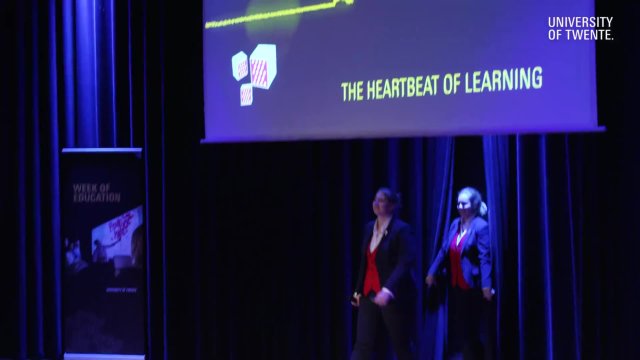Each year during the Week of Education, the University of Twente celebrates outstanding teaching with the UT Teacher of the Year award—a moment to recognise the people who bring learning to life. The event highlights the creativity, dedication, and impact of educators who go above and beyond in higher education. This year, that honour goes to Dr. Janneke Alers, senior lecturer in Cell Biology within the Biomedical Engineering programme. If you’ve ever attended one of Janneke’s classes, you probably already understand why she was chosen.
In this post, we’re speaking with Janneke about her approach to teaching, what she believes makes a classroom truly engaging, and what it means to be recognised for her contributions to education. Curious to know more? Let’s dive into our conversation with Janneke.
To start, could you tell us a bit more about yourself—your background, what you teach, and what drew you to education in the first place?
Sure! I’m a biologist by training—I studied in Utrecht quite some time ago and then did my PhD and postdoc in translational cancer research at the Faculty of Medicine in Rotterdam.. After a policy role at the Dutch Cancer Society, we moved to Twente when my husband started a research group at UT. I began as a program manager for Biomedical Engineering and the minor in Medical and Sports Physiology, where I also started teaching. Very quickly, I realized how much I enjoyed working with students and designing education—especially in cell biology and practicals. Teaching had already drawn me in during my time as a PhD student when I hosted a post-graduate course for research technicians and later on and in 2011, I made the switch to full-time lecturer and module coordinator. I haven’t looked back since.
You had to give a short lecture during the final event—what did you choose to focus on, and why?
Yes! For the lecture, I wanted to do something close to my heart. I don’t have my own research line, but I stay closely connected to research groups to keep my teaching up-to-date. So I thought—what can I share that’s both educational and meaningful to students and also linked to what our research groups are doing? I chose to focus on cell culturing. It’s something I’ve been passionate about since developing our cell biology practical curriculum. I showed how important sterile environments are and highlighted what you can learn from cell behavior—like how they interact with different surfaces or contribute to organ-on-chip technologies, which are very relevant in our department. To make it come alive, I brought some lab equipment and showed a short video—cells dividing, moving, interacting. I wanted to evoke that sense of wonder students experience in the practicals. And it’s in those moments—hands-on, in the lab—students really connect with the content.
Your teaching is known for being both practical and interactive. What are some key principles or strategies you rely on to keep students engaged?
For me, it all starts with how you see your students. I believe we make education together. It’s not “us vs. them”—it’s “we.” That’s the foundation of my teaching. I give students trust and believe they can handle complex tasks, even if they seem difficult at first. I try to create a relaxed and open atmosphere. During online lectures on Blood and Immunology, I might start with a playful playlist—songs with “blood” in the title, for example—to ease them into the topic. I also use interactive methods: quizzes, open questions, and movement, like asking students to stand or sit depending on their answers.
For lab work, I rely heavily on videos and visuals to help students prepare and reduce cognitive overload. Labs can be noisy and overwhelming, so knowing what to expect—through clear images, (safety) videos, and short, even funny but scientifically sound clips—really helps them focus. Over time, I’ve moved more into a guiding role, encouraging peer review and even letting students experiment with tools like ChatGPT to compare safety information with conventional methods. My role now is more about facilitating learning than directing it.
This award brings attention to good teaching practices—what’s one piece of advice you’d give to fellow colleagues (mostly novice) who want to improve their teaching?
First, find a teaching buddy. You learn so much from talking to peers. I believe strongly in the value of a teaching community where we share what works—and what doesn’t. But more importantly, ask yourself: how do I see teaching? Is it a task, or is it a gift? For me, it’s absolutely a gift. I feel so privileged to work with young, curious minds. Of course, I understand that many colleagues are juggling research pressures and deadlines. Teaching can easily become “just another thing.” But if you can connect to why it matters to you personally, it makes a big difference. And don’t try to change everything at once. Small changes can have a big impact. Always reflect—what worked, what didn’t—and be open to tweaking things year after year. That’s how I keep my own spark alive.
Finally, what keeps you inspired to teach, year after year?
The students—without question—are the reason I love what I do. I especially miss working closely with our team of 20–25 handpicked teaching assistants. We trained them, they supported each other, and they helped us innovate. We even had annual barbecues and evaluations together.
What drives me is seeing students grow—whether as TAs, in practicals, or during a deep lab conversation. Some come back years later, now working in hospitals, doing research, or raising families, and they still remember what we built together. That’s incredibly rewarding.
I also enjoy helping students find their direction—not as a study advisor, but as someone they can talk to about their path. Even playing a small part in that journey means everything to me.







